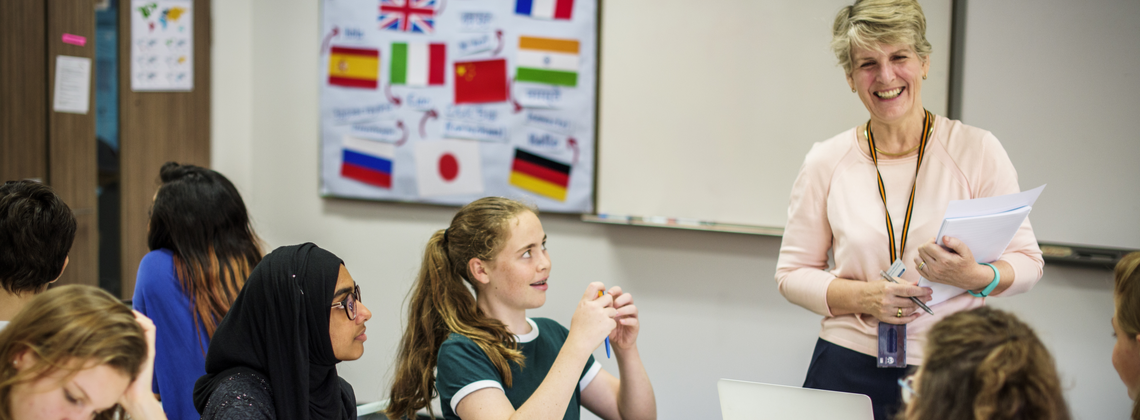

The brilliant thing about learning in the 21st century is that there are hundreds of methods of learning a language.
Thanks to the expansion of resources and the introduction of digital tools, finding a new resource perfected to your learning style isn’t as hard as it was beforehand. Methods of learning a language are now widely available too, with more cost-effective tools available at your fingertips.
In this article, we’ll run over some of the most popular ways to learn a language, covering the methods and resources out there that can be adopted to help acquire language learning skills for your target language.
Benefits of offline and online methods

The explosion of digital apps and resources has been fantastic for those learners who enjoy those type of resources.
But there are still tons of offline methods to learning a language. Whether you are a digital app fan or a zen-out, paper-only focused learner; there’s a resource for you out there. So, what are the differences between offline and online methods?
The benefits of using offline resources are they normally consist of interacting with native speakers in person. A lot of individuals enjoy one-to-one lessons or group workshops as a way to acquire language skills; it gives them a sense of comfort. The direct interaction with others in offline methods can be a great way to connect with others and get you out of the house.
The benefits of using online resources are that they are more flexible and can be used anywhere, in the dark at midnight or even on the train home from work. The ability to access these apps, websites and media learning formats allow for a much more open way to learn. Both of these ways to learn can be used in tandem as well as on their own to help you acquire a new language.
Methods of learning languages

Time for the recommendations. Here are some of the most popular methods of learning a language:
- Flashcards – This method of acquiring a language is very traditional. Many learners today keep this as their default option to pursue a new language. Jotting down the most high-frequency words on flashcards can be a great way to review your progress, every evening before bed or in the morning when you wake up. People even get into the pattern of sticking them on items around the house to help you remember or associate a keyword to the object, this is a very popular but powerful method of learning a language, it helps build associations with new vocabulary and improve your cognitive language learning.Once you’ve created these notes, sit back and start to learn soak in lots of languages. There’s a resource called FlashSticks that are pre-printed Post-it Notes designed to help you learn a language. This method comes highly recommended from students who want to save time but keep using this method to learn.
- 1-to-1 lessons – Speaking to a native speaker or even a teacher who knows the language can dramatically improve your chances of acquiring the language. A lot of people like this method of learning as it integrates accountability. Accountability is important in learning as it helps to stress the learner to keep motivated and consistent with the method of learning, if they decide to quit the session or even leave it a week, they are accountable to their teacher/native speaker. This method is helpful and provides a smooth the way for learners to keep the ball rolling. Other reasons people like this form of learning is it’s interactivity and connection to others, learning with a teacher can give you more insight into the culture, language and fluency than an app might give you. The issue with 1-to-1 sessions are they normally quite expensive and provide difficulty when it comes to getting to the sessions, especially in our time-stressed days.
- Apps – Now the fastest growing method to learn a language, apps have become a predominate way to pick up new vocabulary and improve skills on the go. Apps are improving day by day and showcasing more features from pronunciation to grammar checking, something that even teachers struggle to teach. These new methods are growing in force but provide a more comfortable way for learners to dive into a language by offering an on the go experience in their pocket with little accountability, so they can learn at their own pace, which is helpful for learners. The range of apps does allow for a wide range of languages to be openly available for you to learn, even some dialect and remote languages. As far as a method for language learning, it provides strong insights and helps to build your skills rapidly.
- Online Courses – Online courses have always been a great way to learn a language as the mist of the time they provide insights into learning that many of the sources like flashcards don’t provide. Courses allow learners to go deeper and share their progress as they go, thanks to the stature of courses; people enjoy the approach as they see progress, e.g. 172/500 lessons.The benefit of an online course are the range of languages they offer, you can learn almost all languages from Russian to Korean online. This is the case with the application method however with an online course; it’s very similar to a textbook in style by providing insights into all areas of language learning. But this method of learning is reducing in size thanks to the growth of blogs, podcasts, and media as content becomes more freemium in this area.
- Language Exchange – this is one of the most immersive ways to start learning, throwing yourself in the deep end can be a great to way to start learning a language. Traveling to a new country and staying in another’s place is an excellent way to learn a language. Jumping into the culture and language can be easily down and your rate of learning with increase massively. Again, there is a range of languages that you can experience by jumping into a language exchange and meeting new people.
- Skype Calls – People who don’t enjoy the 1-to-1 meetings but gain value from experience might enjoy skype calls or websites that allow you to connect with a native speaker. This way of learning is a more modern way to learn from your home, sometimes at 1/2 of the cost of a lesson or workshops. Skype or iTalki and alternatives provide a seamless way to meet a native speaker and start learning with them over audio or video calls.There is a range of languages to choose from too from these sites. This method of learning provides insights into culture, language and all in the comfort of your own home.
Motivation to start a language

As we always mention in our pieces, learning a language does require attention and persistence. As you choose your method of learning, it’s wise to understand the level of dedication you need to start a language.
Starting a new language can be very scary when you are getting started, let alone going further into the native tongue. Everything from meeting native speakers to traveling might get you scared and be demotivating you. Make sure to understand as you kick everything off to keep your head down and keep dedicated to learn the language.
Languages can open many doors to new opportunities from job opportunities to your love life.
Learn on the go

Learning on the go, thanks to the online methods of learning is easier than ever, giving you no excuses.
This new method of learning will help to drive your language learning forward and something to embrace. Even if you want to learn on the go but want to want still to retain your offline methods of teaching like flashcards, there’s no problem with you using them on the train home. You won’t look strange or weird, but productive with your time.
Many of the new applications for language learning provide an “offline” mode too, so if your route home is burdened with bad Wi-Fi or signal, you can learn offline too using your tablet or smartphone. For the drivers out there, still, no excuses, podcast learning for a new language is now a popular method of acquiring language through the radio. Download a few podcasts offline and try them when you are traveling to work for optimum language learning.
Languages are beautiful once you can use them across your day and with new people. What method are you learning through and how have you progressed with your languages in the last few months?

